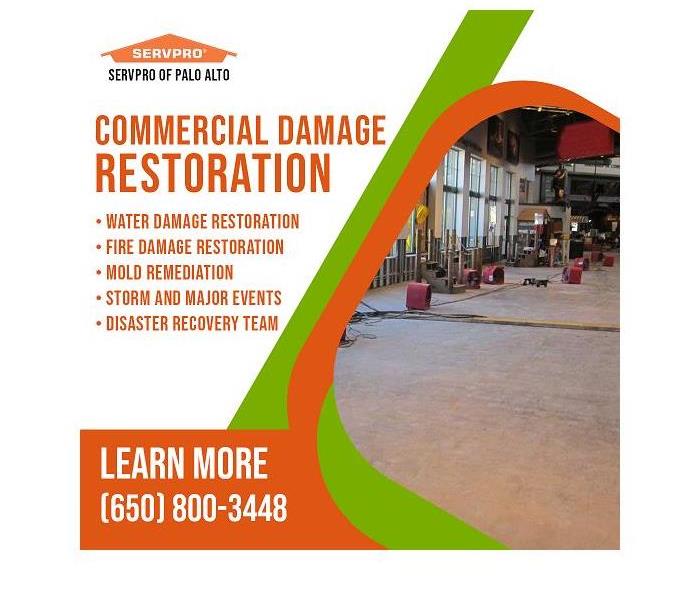Six Steps to Help Employees Report a Commercial Mold Infestation in Their Workplace
5/11/2021 (Permalink)
Blog Summary: SERVPRO of Palo Alto offers tips for reporting a mold infestation in the workplace.
SERVPRO of Palo Alto provides commercial damage restoration services to the local business community. The team of restoration experts can scale to meet any size disaster in any facility, whether it is an educational institution, office complex, service center, bank, retail business, hospital, factory, or apartment complex. SERVPRO has the necessary equipment, training, and techniques to get the job done as quickly as possible with minimal disruption. Mold infestation is a common issue in many workplaces. SERVPRO of Palo Alto is sharing tips to effectively guide employees through the process of reporting mold growth in the workplace or other commercial environments.
Mold in the Workplace
Mold is an unwanted guest in any work environment, and neither employers nor employees want mold issues in the workplace. Health effects can result in workers' comp claims or lawsuits, and property damage leads to costly repairs, especially if sensitive equipment or electronics are affected. The mitigation process can also disrupt the flow of products and services to customers. Discovering and resolving a mold infestation in the early stages can preserve workforce health and save time and money for the business owner or employer.
Mold can cause health effects for a business’ employees. In addition, guests, vendors, and contract workers who visit a facility where a mold infestation exists can be impacted by exposure to the mold, especially if the individuals have pre existing health concerns.
Should mold be discovered in the workplace, the tips listed below help employees work through the process of reporting a potentially dangerous mold situation to their employers.
- Report the discovery.
Inform a supervisor or manager immediately upon discovering mold in the workplace. Report the mold growth by email, text, or other communication platforms so that a record of action is created.
- Include basic information in the report.
Record the time of discovery, the location of the mold outbreak, and the extent of the visible signs of mold. A timestamped incident report helps mitigation experts determine important details about the infestation, such as how long the infestation has been in process, its origin, and the extent of any spread.
- Note environmental details.
Thoroughly describe the location, including any visible signs of moisture or water damage such as:
- heavy condensation on surfaces
- high humidity levels
- leaking pipes or unexplained puddled water
- dark stains
- structural damage such as warped flooring, bubbling paint or peeling wallpaper
- musty smells from vents or air conditioners
- Remind a supervisor or upper-level management of any recent water intrusion that might have a bearing on the mold infestation.
OSHA recommends that wet materials be thoroughly cleaned and dried within one to two days after a water damage incident in order to prevent mold growth.
- Make the report personal.
Speak with responsible parties in person if a timely response to the formal report is not forthcoming. Mold can cause serious health effects that can result in unexpected medical expenses and lost wages for employees.
- Follow up through the chain of command until the issue is acknowledged and a mitigation strategy is adopted.
Both fellow employees and the employer will appreciate a proactive approach to preserve the health of the workforce and the smooth delivery of products and services to customers.
Precautions Employees or Staff Should Take When Dealing With Mold
- Wear protective gear when exposed to mold infestation in the workplace.
Wear eye protection. Utilize a dust-filtration mask to protect the sinuses, mouth, and lungs. Wear rubber gloves, a long-sleeved shirt, and pants, or a full protective suit to prevent skin irritation. Employers are required by law to provide adequate PPE (personal protective equipment) if hazards are present in the workplace.
- Avoid transporting the mold to other parts of the facility, other businesses, or the home environment. Remove PPE after exposure to mold. Wash or discard contaminated items. Upon arriving home, remove clothing — including shoes — that may have been exposed to mold. Wash the clothing immediately, if possible. Do not cross-contaminate personal laundry. Be sure to wash work clothes separately from the rest of the laundry.
- Clean the work environment regularly and resolve water intrusions immediately to prevent mold growth.
- Increase ventilation in affected areas.
- Never assume that mold in the workplace is safe.
The Best Remediation Strategy to Resolve a Commercial Mold Infestation
Take the safest and swiftest course of action to resolve mold issues in the workplace. Call in the professionals at SERVPRO of Palo Alto. A commercial mold infestation can harm employees and disrupt business operations. Mold in the workplace can disrupt production, slow down the provision of services, damage equipment, and the building, and cause health effects in the workforce. SERVPRO of Palo Alto offers commercial mold remediation services designed to resolve the issue as quickly as possible with the least amount of disruption to the business. SERVPRO technicians are certified mold remediation specialists equipped to mitigate any mold issues with the utmost safety.
For more information about Palo Alto, TX, commercial damage restoration, contact the office by phone at (650) 800-3448 or email office@SERVPROpaloalto.com.



 24/7 Emergency Service
24/7 Emergency Service
